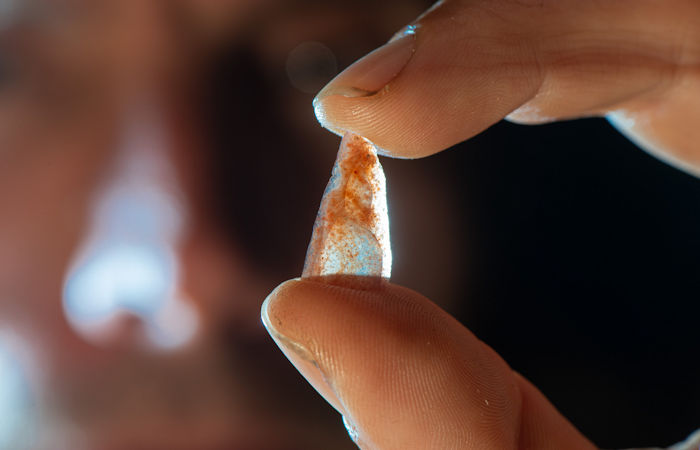Conny Waters – MessageToEagle.com – If the emergence of mechanically propelled weapons in prehistory is commonly perceived as one of the hallmarks of advancing modern human populations into the European continent, archery has always been more difficult to trace.
Dr. Ludovic Slimak showing a Neronian nanopoint found in Grotte Mandrin layer E. The studies of these light points show that these tiny points were used as arrowheads 54.000 years ago in Mediterranean France. Credit: Philippe Psaila
The recognition of these technologies in the European Upper Paleolithic has been hampered by ballistic overlaps between weapons projected with a thruster or a bow.
Archery technologies are essentially based on the use of perishable materials; wood, fibers, leather, resins, and sinew, which are rarely preserved in European Paleolithic sites and make archaeological recognition of these technologies difficult. The flint armatures constitute the main evidence of these weapon technologies.
Based on the analysis of these stone armatures, archery recognition is now well documented in Africa dating back some 70,000 years. Some flint or deer antler armatures suggest the existence of archery from the early phases of the Upper Paleolithic in Europe more than 35,000 years ago.
View of Grotte Mandrin site. Credit: Ludovic Slimak
Still, the morphology and the hafting modes of these ancient armatures do not allow them to be linked to a distinct mode of propulsion, making the possible existence of archery during the European Paleolithic nearly invisible.
The demonstration of Paleolithic archery has been established only on the basis of the discovery of the oldest bows and arrows found in peat bogs of Northern Europe (at the Stellmoor site in Germany, for example) and dated from the 10th to 12th millennium.
Tiny points made by Homo sapiens 54.000 years ago and used as arrowhead. Credit: Laure Metz/Ludovic Slimak
The data from Mandrin cave in Mediterranean France, presented in an article published in Science Advances, profoundly enriches our knowledge of these technologies in Europe and now allows us to push back the age of archery in Europe by more than 40 millennia.
The study is based on the functional analysis of thousands of flint artifacts from the same archaeological level that revealed in February 2022 the oldest occupation of modern humans on the European continent. This very rich level, attributed to the Neronian culture, testifies to Homo sapiens occupations dating back to the 54th millennium and is interposed between numerous Neanderthal occupations occupying the cave before and after the modern human installations.
The Neronian settlement phase excavation revealed no less than 1500 flint points. Their analysis shows that a significant number of them were used as armatures for arrows propelled with a bow. It is the very small size and, more precisely the small width of these armatures, of which some 30% weigh hardly more than a few grams, which allows us to exclude any other mode of ballistic propulsion for these very small weapons.
Up: 1 to 4 Nanopoints from Grotte Mandrin layer E used as arrowheads. Down comparison between a point and a nanopoint . Vicual scale, 1 euro cent. Credit: Laure Metz and Ludovic Slimak
If thanks to this study, archery in Europe, and more broadly throughout Eurasia, makes a remarkable leap back in time, it also sheds light on the weaponry of Neanderthal populations. The study shows that Neanderthals, contemporaries of Neronian modern humans, did not develop mechanically propelled weapons (like technologies using bows or thrusters) and continued to use their traditional weapons based on the use of massive spear-shaped points that were thrusted or thrown by hand, and thus requiring close contact with their game.
The Neronian tiny points found in Grotte Mandrin were experimentally reproduced using the same flint and replicating the same technologies. These experimental tiny point were then used as arrowheads and shot by bow to analyse the categories of fractures appearing on these arrowheads and compare them with the scars found on the archeological material. Comparative studies show that the Neronian archeological tiny points were undebtedfully used as arrowheads. Experiments by Laure Metz, Toomaï Boucherat, Christian Trubère and Ludovic Slimak. Credit: Ludovic Slimak
The traditions and technologies mastered by these two populations were thus profoundly distinct, illustrating a remarkable objective technological advantage to modern populations during their expansion into the European continent.
See also: More Archaeology News
However, in their article, the authors place this debate in a much broader context in which technical choices cannot be limited solely to the cognitive capacities of differing human populations, referring us to the weight of traditions within these Neanderthal and modern human populations as well as to ethologies that may have been profoundly divergent between them.
The study was published in the journal Science Advances
Written by Conny Waters – MessageToEagle.com – AncientPages.com Staff Writer









